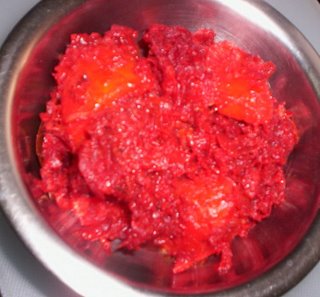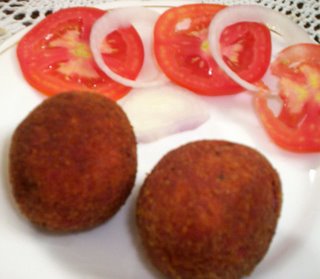Weekend Herb Blogging: Red Beet
 I am returning to Weekend Herb Blogging (WHB), hosted by Kalyn of Kalyn's Kitchen, after a long while. This is one event I always feel glad to attend, and even when I can't participate, I make sure to read the entries that come in week after week. Thanks to Kalyn for creating a platform that helps us get acquainted with an amazing array of fruits, vegetables and herbs from across the globe.
I am returning to Weekend Herb Blogging (WHB), hosted by Kalyn of Kalyn's Kitchen, after a long while. This is one event I always feel glad to attend, and even when I can't participate, I make sure to read the entries that come in week after week. Thanks to Kalyn for creating a platform that helps us get acquainted with an amazing array of fruits, vegetables and herbs from across the globe. My entry for this week is the red delight called beet. While researching for my post, I came across some wonderful facts about this root. In ancient times, Romans used it to cure fever and constipation, besides other diseases. Hippocrates, the father of medicine, advocated the use of beet leaves as a binding for wounds.

Among the sweetest of vegetables, beetroot has considerable amounts of Vitamin C in the root area, while the upper portion contains a good amount of Vitamin A. The health benefits of beet include protection against heart disease, congenital defects and certain types of cancer, mainly colon cancer. More information on this power-packed root can be found here.
My recipe using beetroot is a yummy snack called beet chops. This is similar to fish chop I blogged about earlier, except for the stuffing, which, as you can guess, is made of beet. Well, that's the main ingredient. I also used some carrots in my recipe. This is a popular snack item of Bengali cuisine and tastes delish. Let's get down to it then?

Beet Chop:
Ingredients:
Beet: 2-3 big, grated
Carrot: 2 big, grated
Bay leaves: 2
Tomato: 2, pureed
Garam masala powder (Dry grounded cardamom, cloves and cinnamon): ½ tsp
Cumin seeds: ½ tsp
Ghee (clarified butter): 1 tsp
Raisins, cashew nuts
Salt to taste
Oil for frying
And a paste of:
2 onions
1 inch ginger block
6-8 garlic cloves
For outer cover:
Potatoes: 4-5 big, boiled, mashed
Bread slices: 3-4
Egg: 1
Bread crumbs
Salt, pepper
Method:
The Stuffing:
1. Heat oil in a wok and add the cumin seeds and bay leaves.
2. Add the onion-ginger-garlic paste and garam masala powder. Stir a bit.
3. When the masala starts drying, add the grated beet and carrot. Stir well. Add salt.
4. Lower heat, cover and cook for 15-20 minutes or until the water starts drying.
5. Remove cover, stir constantly, and add the ghee. Let the mix dry completely.
6. Add the raisins and cashew nuts and mix well.
Your stuffing is ready. Remove from heat and let it cool.

Making the Chop:
1. Mix the mashed potatoes, bread slices, salt and pepper. Add an egg and bind into a dough.
2. Take a roundel of the dough and make a cavity.
3. Fill the cavity with the stuffing and seal the edges.
4. Shape into a chop (we made round ones; you can give it an oval shape too, or make it flatter, if you like).
5. Roll the chop over bread crumbs and deep fry them in batches.
6. Serve hot with onion rings and tomatoes or sauces/chutneys of your choice.

The chop is extremely delicious what with the soft and sweet texture of the beet alongside the savoury taste of potato, bread and salt. It's one of my favourite snacks, and I hope you will savour it too. Enjoy!
Sury










